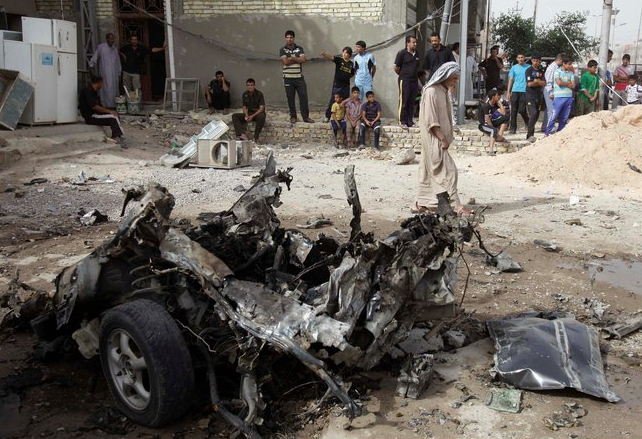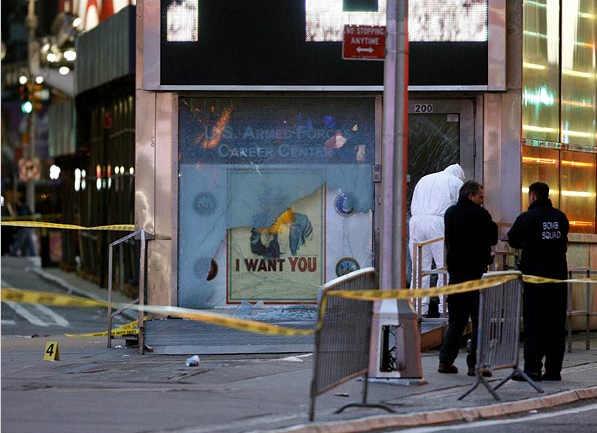The photograph above appeared on the front page of the NYT a few days ago in conjunction with a story concerning a series of bomb blasts that rocked Baghdad killing twenty people, including 8 Iraqi policemen and two U.S. soldiers. At first glance, the image is altogether banal. The remnants of the wreckage in the foreground are barely recognizable, with only a single tire giving a clue as to its identity as a vehicle. The absence of security personnel or emergency vehicles make it apparent that the explosion did not just happen. And the individuals sitting and standing in the background are altogether relaxed, if not nonchalant, their attention dispersed in multiple directions, making it difficult to know what event the photograph is actually recording—the scene in front of us, whatever is outside of the frame of the image, or something else altogether. Indeed, on the face of things the photograph does not appear to be an image of anything in particular at all.
At second glance, however, it may well be the very banality of the image that makes it especially worthy of our attention. An explosion has taken place, or more specifically, as the caption directs the reader, “a series of attacks” have taken place, and yet any sense of urgency in dealing with the situation is altogether elided. Everyday life has been disrupted, to be sure, tragically so with the violent loss of life, but the event is shown to be so routine, so commonplace, that its status as a horrifying emergency claim goes unnoticed and unaddressed. The photograph thus purports to be the visual representation of a slice of life in a society that has become conditioned to such everyday violence, so much so that it lives, in Ariella Azoulay’s terms, “on the verge of catastrophe.” This is not an appeal to the now tired idea of “compassion fatigue,” which claims that we become so weary of images of violence and disaster that we simply stop noticing. Rather, it suggests the sense in which “the contours [of the scene represented] are indistinct; one could easily fail to notice it, passing in front of it without stopping.” It is portrayed as a nonevent, however quotidian it might be, and thus it never rises to the level of an emergency claim. Put simply, the everydayness of the scene, which should alert us to the profound, catastrophic condition of the society, actually veils—if not altogether erases—the tragedy before our eyes.
To get the point, compare the photograph above with the photograph and slide show that the NYT published in conjunction with the 2008 bombing of a U.S. Army recruiting station in Times Square.
No one was injured in this blast, the physical damage to the building was relatively minor, and disruption to the city lasted for only a few hours, but nevertheless, all of the signs of urgency and emergency are present and pronounced. Yellow tape marks the scene as the site of a dangerous criminal act. Members of the bomb squad—state officials—stand post in front of what appears to be a technical expert dressed in a hazardous materials suit as he examines the bomb’s residue. And note too that the explosion took place in the early morning hours and the street lamps in the background are still on, suggesting the immediacy with which the event was responded to and handled. Everything in the image casts this as a special event and in so doing initiates the conditions for classifying it as a catastrophe.
The point, of course, is that catastrophes come in a variety of forms. The problem is not in reducing the conditions for defining a catastrophe to a singular event, but in how we visualize those conditions as a matter of urgency.
Photo Credits: Karim Kadim/AP; Chip East/Reuters. And with special credit to Ariella Azoulay’s The Civil Contract of Photography (New York: Zone Books, 2008). Esp. 289-373.


No so much different than the U.S.A. where are are ~115 car crashes per day and just about that number of fatalities due to those crashes:
http://www.car-accidents.com/
http://en.wikipedia.org/wiki/List_of_motor_vehicle_deaths_in_U.S._by_year
Most of the photos on the first site are, one would guess, taken right after the accident as police, firemen, etc. are in evidence. But how about an hour or so after and before the remains have been taken away? I myself crossed in front of a motorcycle I didn’t see and the twisted wreak sat there for a day or so. No big deal. “Move along now, nothing to see.”
Dave: The difference, of course, is that the cars you show were wrecked “by accident” and not by design. Such accidents are tragic … are they catastrophic?
And notice, too, that they rarely if ever show up in the news.
I have a hard time differentiating “tragic” vs. “catastrophic” as I have differentiating “accidental” vs. “collateral damage.” IMO it goes along with (“our” “courageous”) soldiers don’t kill “people” but rather “gooks,””Japs,” “huns,” and whatever in previous wars.
I agree that language can be vague and that allows those who have an interest in doing so to manage it in euphemistic ways. But just because language is vague or that linguistic differences hinge on fine lines is no reason to throw our hands up in total exasperation and to say that there are no differences worth parsing. Indeed, good judgment requires us to seek out such distinctions. An “accident” is something that is not planned and cannot be anticipated in any direct or immediate way. “Collateral damage” frames specific events as something like an accident BUT it is also somewhat paradoxical in this regard in that it operates with the assumption that such “accidental events” are more or less planned and anticipated, i.e., they are not really accidental, but the costs of war that we just can’t specify in advance. “Tragedies” are events that occur as a result of human failings. We can imagine how they can be otherwise. “Catastrophes” are sometimes tragic (e.g., impact of Katrina on New Orleans), but other times not quite so clearly so (e.g., the twisters that took out Tuscaloosa). And in any case, they are understood to be cataclysmic in magnitude. Thousands of people dying annually in car wrecks is surely tragic in this regard. The question is, at what point does it rise to the level of a catastrophe? What are the conditions of possibility for a catastrophe to occur—and for us to respond as such? And note that I’m not saying that it could not be so considered, but the fact is, it is generally not so considered. What would have to change to see it as a catastrophe?
The point of the original post was to call attention to how visual representation plays a vital role in establishing that something ought to be understood as catastrophic or not. And beyond that, to consider another possible category, “being on the verge of catastrophe.” The question is, in what sense might we imagine the representation of car wrecks as pointing us to the “verge of catastrophe”?
To some point, I agree. Language definitely can be vague and euphemistic, yet so often the euphemism for one side of a conflict is quite different than for the opposing side (where by “euphemism” I include photos).
However what’s particularly curious is how all too often the number of (American) people who died in the 9/11 and its aftermath only counts death-by-terrorist where the question of “Why do they hate us?” as answered by” They hate our freedoms.”
Yet if you read what Osama bin Laden actually said — as in “Messages to the World: The Statements of Osama bin Laden” — the answer is quite clear and has nothing to do with the above questions and answers. I agree with the translator who says, “This book is intended to provide a better understanding of the dynamics of political Islam, not an endorsement of bin Laden’s ideas.”
In my experience, before we can come with an effective response to a situation we need to understand what it is as fully and completely as possible.
Saw this blog mentioned in the BJP and found great content here – will definitely come back!
Cheers
Richard